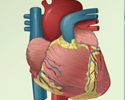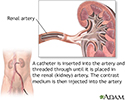Renovascular hypertension
Renal hypertension; Hypertension - renovascular; Renal artery occlusion; Stenosis - renal artery; Renal artery stenosis; High blood pressure - renovascularRenovascular hypertension is high blood pressure due to narrowing of the arteries that carry blood to the kidneys. This condition is also called renal artery stenosis.
High blood pressure
Blood pressure is a measurement of the force exerted against the walls of your arteries as your heart pumps blood to your body. Hypertension is the ...

Causes
Renal artery stenosis is a narrowing or blockage of the arteries that supply blood to the kidneys.
The most common cause of renal artery stenosis is a blockage in the arteries. This problem most often occurs when a sticky, fatty substance called plaque builds up on the inner lining of the arteries, causing a condition known as atherosclerosis.
When the arteries that carry blood to your kidneys become narrow, less blood flows to the kidneys. The kidneys mistakenly respond as if your blood pressure is low. As a result, they release hormones that tell the body to hold on to more salt and water. This causes your blood pressure to rise.
Risk factors for atherosclerosis:
- High blood pressure
- Smoking
- Diabetes
- High cholesterol
- Heavy alcohol use
- Cocaine abuse
- Increasing age
Fibromuscular dysplasia is another cause of renal artery stenosis. It is typically seen in women under age 50. It tends to run in families. The condition is caused by abnormal growth of cells in the walls of the arteries leading to the kidneys. This also leads to narrowing or blockage of these arteries.
Symptoms
People with renovascular hypertension may have a history of very high blood pressure that is hard to bring down with medicines.
Symptoms of renovascular hypertension include:
- High blood pressure at a young age
- High blood pressure that suddenly gets worse or is hard to control
- Kidneys that are not working well (this can start suddenly)
- Narrowing of other arteries in the body, such as to the legs, the brain, the eyes and elsewhere
- Sudden buildup of fluid in the air sacs of the lungs (pulmonary edema)
Pulmonary edema
Pulmonary edema is an abnormal buildup of fluid in the lungs. This buildup of fluid leads to shortness of breath.
 ImageRead Article Now Book Mark Article
ImageRead Article Now Book Mark Article
If you have a dangerous form of high blood pressure called malignant hypertension, symptoms can include:
- Bad headache
- Nausea or vomiting
- Confusion
- Changes in vision
- Nosebleeds
Exams and Tests
The health care provider may hear a "whooshing" noise, called a bruit, when placing a stethoscope over your belly area.
The following blood tests may be done:
- Cholesterol levels
-
Renin and aldosterone levels
Aldosterone
The aldosterone blood test measures the level of the hormone aldosterone in blood. Aldosterone can also be measured using a urine test.
Read Article Now Book Mark Article -
BUN (blood urea nitrogen)
BUN (blood urea nitrogen)
BUN stands for blood urea nitrogen. Urea nitrogen is what forms when protein breaks down. A test can be done to measure the amount of urea nitrogen ...
 ImageRead Article Now Book Mark Article
ImageRead Article Now Book Mark Article -
Creatinine
Creatinine
The creatinine blood test measures the level of creatinine in the blood. This test is done to see how well your kidneys are working. Creatinine in t...
 ImageRead Article Now Book Mark Article
ImageRead Article Now Book Mark Article -
Potassium
Potassium
This test measures the amount of potassium in the fluid portion (serum) of the blood. Potassium (K+) helps nerves and muscles communicate. It also ...
 ImageRead Article Now Book Mark Article
ImageRead Article Now Book Mark Article -
Creatinine clearance
Creatinine clearance
The creatinine clearance test helps provide information about how well the kidneys are working. The test compares the creatinine level in urine with...
 ImageRead Article Now Book Mark Article
ImageRead Article Now Book Mark Article
Imaging tests may be done to see if the kidney arteries have narrowed. They include:
- Angiotensin converting enzyme (ACE) inhibition renography
- Doppler ultrasound of the renal arteries
- Magnetic resonance angiography (MRA)
-
Renal artery angiography
Renal artery angiography
Renal arteriography is a special x-ray of the arteries of the kidneys.
 ImageRead Article Now Book Mark Article
ImageRead Article Now Book Mark Article
Treatment
High blood pressure caused by narrowing of the arteries that lead to the kidneys is often hard to control.
One or more medicines are needed to help control blood pressure. There are many types available.
- Everyone responds to medicine differently. Your blood pressure should be checked often. The amount and type of medicine you take may need to be changed from time to time.
- Ask your provider what blood pressure reading is right for you.
- Take all medicines the way your provider prescribed them.
Have your cholesterol levels checked, and treated if it is needed. Your provider will help determine the right cholesterol levels for you based on your heart disease risk and other health conditions.
Lifestyle changes are important:
Lifestyle changes
A stent is a tiny tube placed into a hollow structure in your body. This structure can be an artery, a vein, or another structure, such as the tube ...

- Eat a heart-healthy diet.
- Exercise regularly, at least 30 minutes a day (check with your doctor before starting).
- If you smoke, quit. Find a program that will help you stop.
- Limit how much alcohol you drink: 1 drink a day for women, 2 a day for men.
- Limit the amount of sodium (salt) you eat. Aim for less than 1,500 mg per day. Check with your doctor about how much potassium you should be eating.
- Reduce stress. Try to avoid things that cause stress for you. You can also try meditation or yoga.
- Stay at a healthy body weight. Find a weight-loss program to help you if you need it.
Further treatment depends on what causes the narrowing of the kidney arteries. Your provider may recommend a procedure called angioplasty with stenting.
These procedures may be an option if you have:
- Severe narrowing of the renal artery
- Blood pressure that cannot be controlled with medicines
- Kidneys that are not working well and are becoming worse
However, the decision about which people should have these procedures is complex, and depends on many of the factors listed above.
Possible Complications
If your blood pressure is not well controlled, you are at risk for the following complications:
-
Aortic aneurysm
Aortic aneurysm
The aorta is the main blood vessel that supplies blood to the abdomen, pelvis, and legs. An abdominal aortic aneurysm (AAA) occurs when an area of t...
 ImageRead Article Now Book Mark Article
ImageRead Article Now Book Mark Article -
Heart attack
Heart attack
Most heart attacks are caused by a blood clot that blocks one of the coronary arteries. The coronary arteries bring blood and oxygen to the heart. ...
 ImageRead Article Now Book Mark Article
ImageRead Article Now Book Mark Article -
Heart failure
Heart failure
Heart failure is a condition in which the heart is no longer able to pump oxygen-rich blood to the rest of the body efficiently. This causes symptom...
 ImageRead Article Now Book Mark Article
ImageRead Article Now Book Mark Article -
Chronic kidney disease
Chronic kidney disease
Chronic kidney disease is the slow loss of kidney function over time. The main job of the kidneys is to remove wastes and excess water from the body...
 ImageRead Article Now Book Mark Article
ImageRead Article Now Book Mark Article -
Stroke
Stroke
A stroke occurs when blood flow to a part of the brain stops. A stroke is sometimes called a "brain attack. " If blood flow is cut off for longer th...
 ImageRead Article Now Book Mark Article
ImageRead Article Now Book Mark Article -
Vision problems
Vision problems
High blood pressure can damage blood vessels in the retina. The retina is the layer of tissue at the back part of the eye. It changes light and ima...
 ImageRead Article Now Book Mark Article
ImageRead Article Now Book Mark Article -
Poor blood supply to the legs
Poor blood supply to the legs
Peripheral artery disease (PAD) is a condition of the blood vessels that supply the legs and feet. It occurs due to narrowing of the arteries in the...
 ImageRead Article Now Book Mark Article
ImageRead Article Now Book Mark Article
When to Contact a Medical Professional
Contact your provider if you think you have high blood pressure.
Contact your provider if you have renovascular hypertension and symptoms get worse or do not improve with treatment. Also call if new symptoms develop.
Prevention
Preventing atherosclerosis may prevent renal artery stenosis. Taking the following steps can help:
- Lose weight if you are overweight.
- Ask your provider about your smoking and alcohol use.
- Control your blood sugar if you have diabetes.
- Make sure your provider is monitoring your blood cholesterol levels.
- Eat a heart-healthy diet.
Heart-healthy diet
A healthy diet is an important factor in reducing your risk for heart disease.
 ImageRead Article Now Book Mark Article
ImageRead Article Now Book Mark Article - Get regular exercise.
References
Textor SC. Renovascular hypertension and ischemic nephropathy. In: Yu ASL, Chertow GM, Luyckx VA, Marsden PA, Skorecki K, Taal MW, eds. Brenner and Rector's The Kidney. 11th ed. Philadelphia, PA: Elsevier; 2020:chap 47.
US Preventive Services Task Force, Krist AH, Davidson KW, Mangione CM, et al. Screening for hypertension in adults: US Preventive Services Task Force Reaffirmation Recommendation Statement. JAMA. 2021;325(16):1650-1656. PMID: 33904861 pubmed.ncbi.nlm.nih.gov/33904861/.
Victor RG. Arterial hypertension. In: Goldman L, Schafer AI, eds. Goldman-Cecil Medicine. 26th ed. Philadelphia, PA: Elsevier; 2020:chap 70.
Victor RG. Systemic hypertension: mechanisms and diagnosis. In: Zipes DP, Libby P, Bonow RO, Mann DL, Tomaselli GF, Braunwald E, eds. Braunwald's Heart Disease: A Textbook of Cardiovascular Medicine. 11th ed. Philadelphia, PA: Elsevier; 2019:chap 46.
Victor RG, Libby P. Systemic hypertension: management. In: Zipes DP, Libby P, Bonow RO, Mann DL, Tomaselli GF, Braunwald E, eds. Braunwald's Heart Disease: A Textbook of Cardiovascular Medicine. 11th ed. Philadelphia, PA: Elsevier; 2019:chap 47.
-
Hypertensive kidney - illustration
The kidneys filter wastes and excrete fluid when the pressure of blood in the bloodstream forces blood through the internal structures of the kidney.
Hypertensive kidney
illustration
-
Renal arteries - illustration
A renal angiogram is a test used to examine the blood vessels of the kidneys. The test is performed by threading a catheter through the main vessel of the pelvis, up to the renal artery that leads into the kidney. Contrast medium is then injected into the renal artery through the catheter, and images of the vessels of the kidney are taken. The test is a useful aid in diagnosing any narrowing of the arteries, blood clots, tumors, or aneurysms.
Renal arteries
illustration
-
Hypertensive kidney - illustration
The kidneys filter wastes and excrete fluid when the pressure of blood in the bloodstream forces blood through the internal structures of the kidney.
Hypertensive kidney
illustration
-
Renal arteries - illustration
A renal angiogram is a test used to examine the blood vessels of the kidneys. The test is performed by threading a catheter through the main vessel of the pelvis, up to the renal artery that leads into the kidney. Contrast medium is then injected into the renal artery through the catheter, and images of the vessels of the kidney are taken. The test is a useful aid in diagnosing any narrowing of the arteries, blood clots, tumors, or aneurysms.
Renal arteries
illustration
Review Date: 5/10/2022
Reviewed By: Deepak Sudheendra, MD, MHCI, RPVI, FSIR, Founder and CEO, 360 Vascular Institute, with an expertise in Vascular Interventional Radiology & Surgical Critical Care, Columbus, OH. Review provided by VeriMed Healthcare Network. Also reviewed by David C. Dugdale, MD, Medical Director, Brenda Conaway, Editorial Director, and the A.D.A.M. Editorial team.





